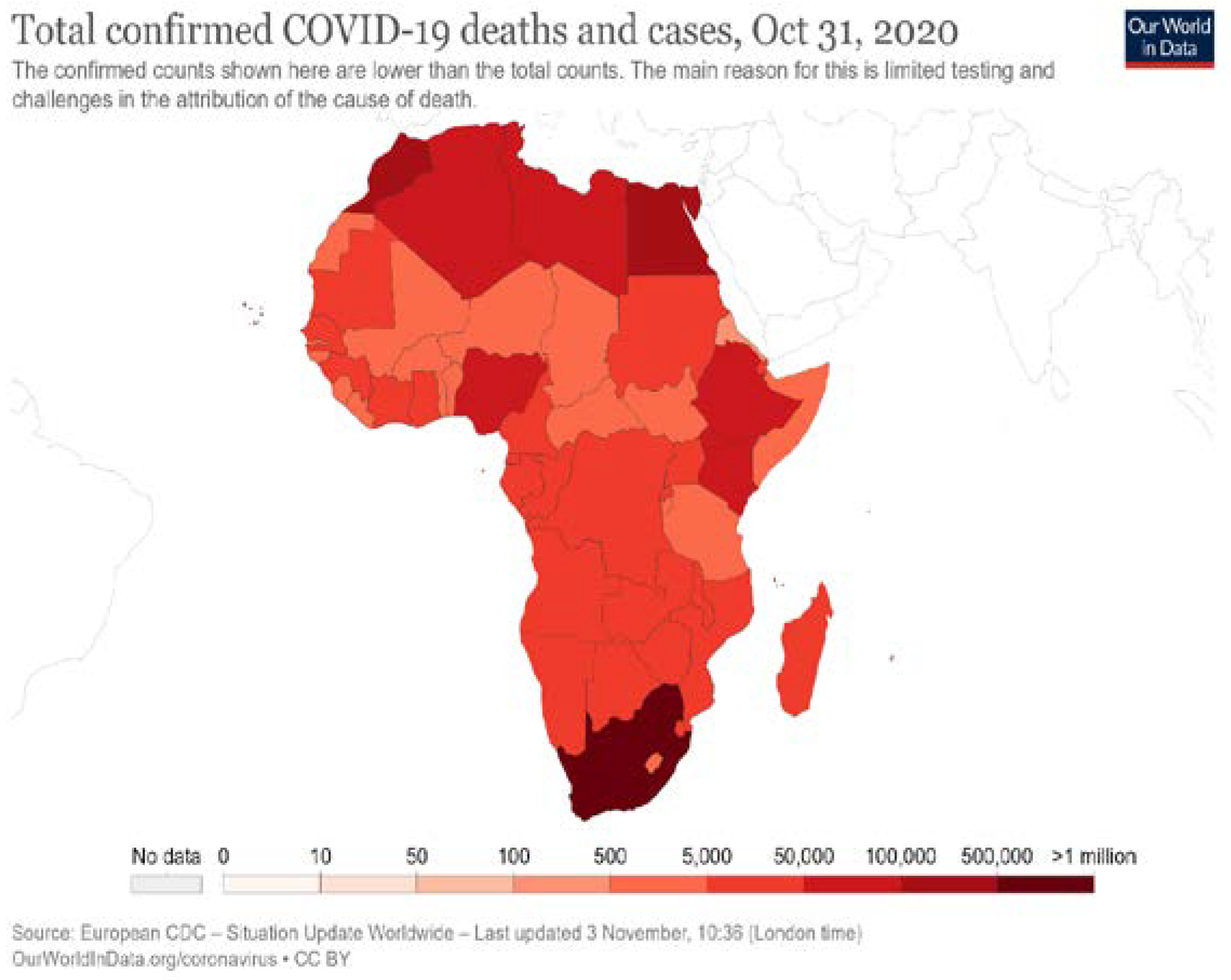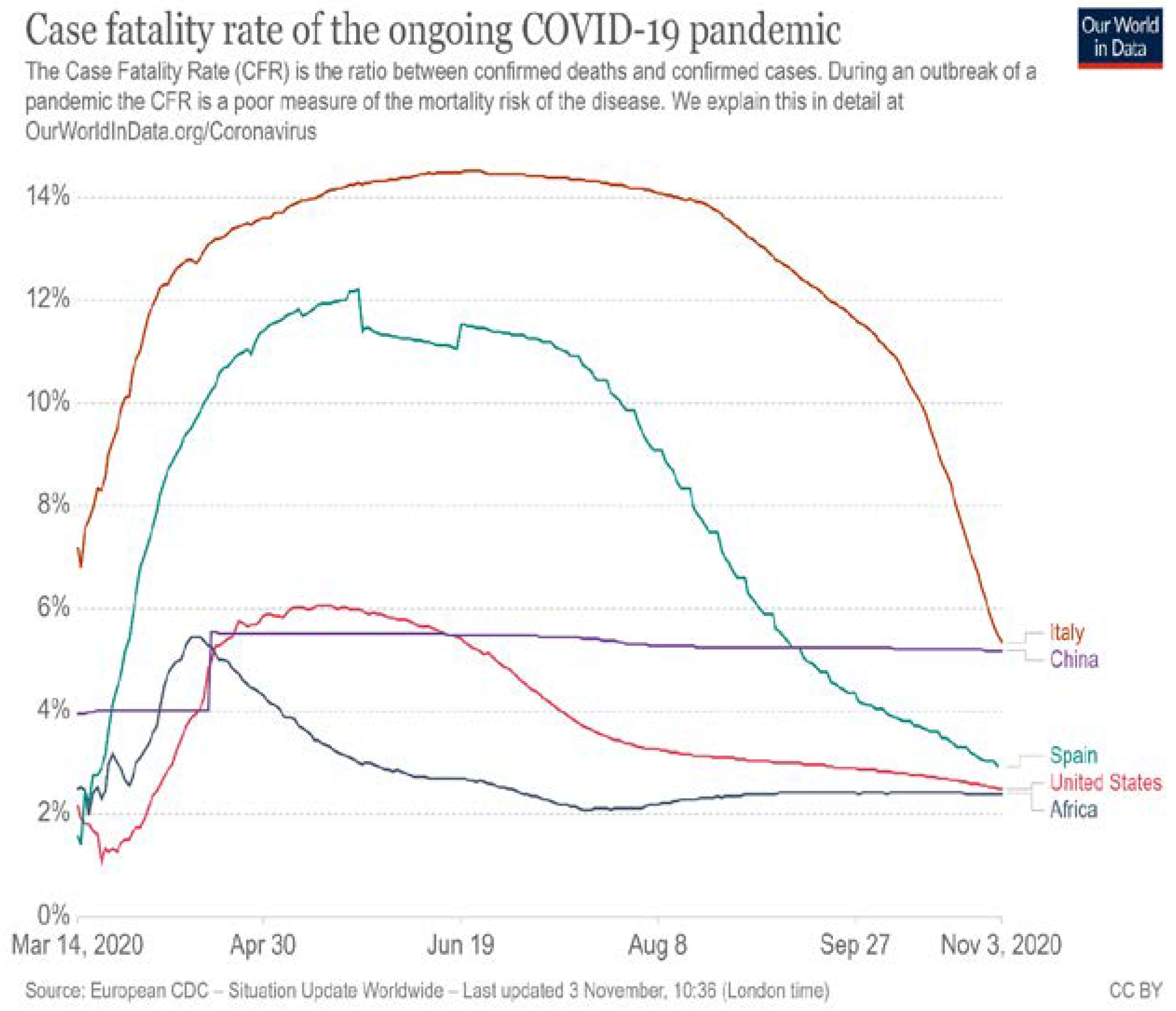Verifying the estimates of COVID-19 deaths in Africa is quintessential due to the known vulnerability of the African continent to diseases in previous times.
1 The rapid transmission and associated dangers of coronavirus disease (COVID-19) has gained media publicity and public health concern [
1]. COVID-19 was declared a public health emergency of international concern on the 31st January 2020 and a global pandemic on 11th March 2020 by the World Health Organization [
1]. As of 31st October 2020, 45,667,575 COVID-19 cases have been confirmed and 1,189,499 deaths have been recorded globally. In Africa, 1,796,748 cases and 42,481 deaths have been recorded [
2]. (
Figure 1). With 17% of the global population, the African continent has an equivalent of 5% of the global confirmed cases and nearly 3% of fatalities. Africa’s COVID-19 case fatality rate (CFR) is nearly 2%, a figure lower than the CFR in countries that have been majorly hit by COVID-19 (
Figure 2). Although COVID-19 infections are at a minimal level in Africa, the similarities of COVID-19 with several other infections could mask accurate reporting of infections and associated deaths. These symptoms include fever, headache, anosmia, loss of sense of taste which have been previously linked to some other infections and are presently highly suggestive of COVID-19. Olfactory and taste disorders have also been reported among hospitalized COVID-19 patients, while cough, body weakness, and diarrhea have been reported among community members who have tested positive for COVID-19 [
1,
3]. Many notions, including spurious tales regarding COVID-19 and related deaths have made the rounds across African communities [
1]. However, community-wide transmission of COVID-19 has gradually evolved to replace the international spread of COVID-19 through contact with travelers. Some probing questions therefore need to be answered: Are the reported cases of COVID-19 a true reflection of the situation in Africa? How frequently are COVID-19 related deaths missed in the overall COVID-19 fatalities reports? These will provide concrete evidence to verify the actual estimate of COVID-19 deaths in Africa, and thereby inform on the strategies for improving death reporting. In this correspondence, we sought to share our views on these and strategies for the improvement of reporting COVID-19 related deaths in the African context.
Vital Statistics Registration System
The Vital Statistics Registration System (VSRS) is an individualized system which is concerned with the continuous registration, documentation, and analysis of vital events in a country [
4].
These vital events are backed by statutory enactments within a defined geographical location and include live births, deaths, marriages, and migrations. Data obtained from the VSRS are useful in public health analysis, and policy planning and implementation [
4]. Unfortunately, the VSRS in Africa suffers incompleteness, an outplay of unfavorable social conditions which favor the non-registration of key events such as deaths [
4]. The immediate burials of dead persons in some African settings also prevent the verification of the actual cause of death.
Thus, many COVID-19 attributable deaths go unreported and uncaptured by the VSRS.
Present state of COVID-19 infection rates and deaths
Many deaths have occurred during the COVID-19 era for which no explanation has been proffered. Incorporating the deaths of probable symptomatic COVID-19 cases, but who were not tested prior to their deaths into the aggregate COVID-19 data is currently lacking across African communities. In this regard, more cases and fatalities increasingly occur in African communities, for whom accurate reporting is required.
The need for death quantification
Despite the pockets of COVID-19 cases obtained recently in Africa, many African countries have tested less than 1% of their population [
4]. Nigeria, the country with the largest population in Africa has tested less than 1% of her residents [
4]. In Nigeria, COVID-19 tests were being conducted for individuals who were willing to take the test, however, presently tests are being conducted for individuals who meet the COVID-19 eligibility criteria only. These criteria include a history of contact with a suspected case of COVID-19, manifestation of one or more of the following symptoms: prolonged cough, fever, body weakness, diarrhea, conjunctivitis, etc. A claim of COVID-19 defeat by the Tanzanian government has hindered the release of COVID-19 figures since May 2020 [
4]. The South African government is however an exemption to the experience of low testing rates as found in other African countries [
4]. Occasional interruption of the testing activity due to shortage of human and material resources has masked the true reflection of COVID-19 infection rates and associated deaths.
In a few instances, rapid, easy-to-perform seroprevalence studies have been conducted to estimate the extent of the spread of COVID-19 with a high positivity rate [
5]. Building on the results obtained from other settings, seroprevalence studies on selected random samples could be applied to the African context to estimate the actual burden of COVID-19. The polymerase chain reaction (PCR) is a molecular testing method which yields highly valid test results, with high sensitivity, specificity, and positive predictive value, however the cost cannot be affordable by the average household in Africa. Therefore, serological or rapid serological tools which yield results with lower validity are more affordable to the average household on the African continent.
Diagnosis and contact tracing of COVID-19 positives have been faced with many challenges on the African continent. These include poor perception of COVID-19 among members of the population, stigmatization of confirmed COVID-19 positives, and non-disclosure of contacts. However, community-wide public health campaigns are ongoing to address these challenges and improve COVID-19 diagnosis and contact tracing activities. As a result, timely interventions would not be accurately delivered due to a lack of robust and adequate data on COVID-19 related deaths. In addition, incomplete data capture of COVID-19 deaths could impede the planning and implementation of policies which are needed in addressing the COVID-19 pandemic.
The journey ahead
The knowledge of the true estimates of COVID-19 deaths is needful at this period. In the enhancement of COVID-19 death reports, multisectoral collaboration could involve joint activities between relevant ministries, agencies, and stakeholders in the coordination and implementation of response activities. Also, field investigations and surveillance activities need to be heightened in the diagnosis of infected persons and identification of contacts. Also, public-private collaboration with the national governments in different African countries is highly required at this critical period. When these measures are simultaneously effected, accurate reporting of COVID-19-related deaths would be enhanced across the African continent.
The Surveillance and Outbreak Response Management System (SORMAS) is a system developed by the consortium of National Centers for Disease Control and the Helmholtz Centre for Infection Research (HZI) for resource-limited settings. SORMAS aims to improve disease surveillance and strengthen the public health service. The system similarly gathers daily intelligence reports regarding COVID-19 infections and deaths. However, proper coordination and intensified efforts during the COVID-19 outbreak response are required to ensure complete documentation of COVID-19-related deaths. Also, an evaluation of the surveillance system could serve to improve COVID-19 reporting.
The engagement of community mobilization teams, religious heads, traditional leaders, and opinion leaders has helped to enhance community-wide testing in African countries. The involvement of community informants will enhance the commencement of prompt actions and enable accurate death records in events of deaths of COVID-19 infected persons. Community-based health workers and community pharmacists could also actively link community mobilization teams and ailing community members to COVID-19 centers. This will enable the horizontal approach in the COVID-19 response to improve the reporting of deaths in African communities.
In addition, active case search and follow-up in hospitals, clinics, and other health facilities would help identify the true rates of COVID-19 cases and deaths among patients and health workers alike. The inspection of death registers would also help to decipher accurately the cause of death among individuals during the COVID-19 period. Mortality surveillance needs to commence alongside an intensification of the evaluation of surveillance activities.
Conclusions
In adapting to the true state of COVID-19 in Africa, the collaborative efforts of all stakeholders, governmental and non-governmental organizations, and benevolent individuals are highly required. When tasks are well executed, members of the public would no longer live in the oblivion regarding the true state of COVID-19 infection and associated fatalities but will intentionally and adequately equip themselves for its prevention.





